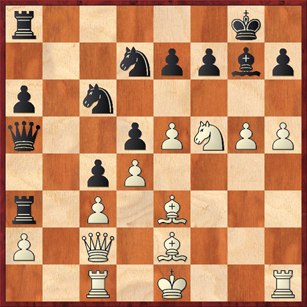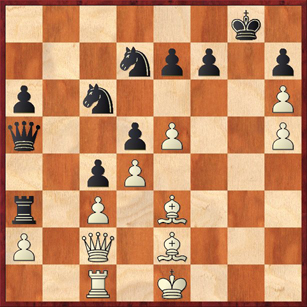Here is the finish of one of my better games from this weekend’s CalChess Labor Day Championship. It’s round four, and I’m playing the White pieces against yet another teen-age Class A hotshot, whose name is Sreekar Jasthi. (White to move.)
As you can see, both sides have been attacking on opposite wings, but White’s attack has arrived a lot faster. It’s definitely time to strike, because if it were Black’s move he could play … Rxa2 and drive White’s queen away from its beautiful diagonal. Can you analyze the position all the way to a win for White?
I looked at the position on the computer this morning, and it finds lots of ways for White to win. So the exercise here is really not to find the unique winning move, but simply to find a good move and analyze it all the way to the end. At this point I had 22 minutes left to make 7 moves, so time wasn’t too big of an issue. I actually thought about this move for 5 minutes. Here’s what I came up with:
24. Nh6+! … The exclam is really for seeing the combination all the way to the end. If you’re wondering about 24. Nxg7!, which seems more obvious, that is also good, and in fact it is the computer’s top choice. The main line continues 24. Nxg7! Kxg7 (Black can’t kick the queen with 24. … Rxa2 because of 25. Qf5, which wins the knight on d7. An ongoing theme here is that the White queen is free to leave c2 after Black commits himself to … Rxa2, because with the pressure on c3 released Black really doesn’t have much of an attack.) 25. g6! e6 (Best; Black is preventing Qf5.) 26. gf Rxa2 (But now where does White’s queen go?) 27. Rg1+ Kh8 28. Bh6!! White says, “Go ahead and take my queen! I don’t care!” Black has no good way to prevent checkmate. Maybe if I had seen this I would have played 24. Nxg7 … but I didn’t.
Continuing with the game: After 24. Nh6+ Black played 24. … Bxh6, which was forced, because otherwise White wins a pawn on f7 or h7 with immediate and disastrous threats. After 25. gh Kh8 26. Rg1 Rg8 (Black has other possibilities, but this is the most logical move and is certainly what I expected. He doesn’t want to allow 27. Rg7.) 27. Rxg8+ Kxg8 we got to this position, which I had foreseen on move 24.
I really love White’s next move, which does four things at once: 1) It clears a line for White’s queen (a clearance sacrifice); 2) It defends a2; 3) If Black accepts the sacrifice, it clears a second line for White’s queen that leads to immediate recovery of the material; and 4) After that, it creates a back-rank mating threat! It’s amazing to find a move that does so many things at once. The move is, of course, 28. Bxc4!
Ironically, the computer prefers 28. Kf2! which simply steps out of trouble and prepares moves like Qf5 and Rg1+. Computers. They’re such spoilsports. I still love 28. Bxc4, no matter what Fritz may say.
As you’ve worked out now, after 28. … dc 29. Qg2+ Kf8 30. Qxc6 White is a pawn up, threatens either Qa8 mate or Qc8 mate (so Black does not have time to play … Rxc3), and can also win the c4 pawn at his leisure. That’s as far as I got in my analysis on move 24, and I stopped here and concluded White was winning. The computer actually points out one resource for Black that I didn’t see: 30. … Nb6, which miraculously defends both checkmates and defends the pawn on c4! This might have really thrown me for a loop. But the computer also finds a very neat retort for White: 31. Rc2!!, a beautiful quiet move. The point is that after 31. … Rxc3 32. Bd2! Black can no longer break the pin with a check. If he plays 32. … Re3+ 33. Kf2 his queen and rook are both en prise. So the conclusion is that yes, White is winning after 30. Qxc6, albeit a little less routinely than I thought.
Of course, the game isn’t played by computers, it’s played by humans. And my human opponent was visibly demoralized by the unexpected 28. Bxc4. He meekly played 28. … Kf8, and after 29. Bb3 White was winning easily. Black’s pressure on the queenside is now completely neutralized, and there is nothing that he can do to prevent 30. Qxh7, followed by 31. Qc2 and 32. h7.
This game gave me a score of 3-1 after four rounds and provided me with a big morale boost going into the last day of the tournament. It’s always encouraging not just to win, but to win with a tactical gem.
Update: If any of you are interested, complete standings of the Labor Day tournament are at http://sacramentochessclub.org/weekend_events/2008laborday.htm. Also, Michael Aigner has a nice writeup of the tournament at his blog, mostly featuring the results in the Master section.




